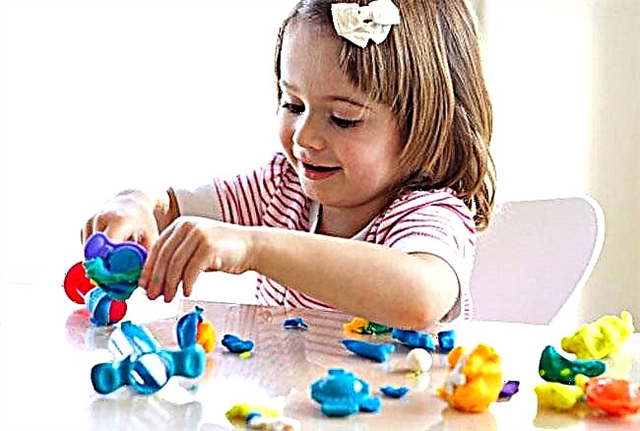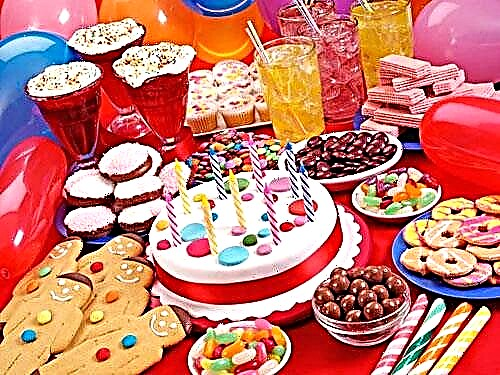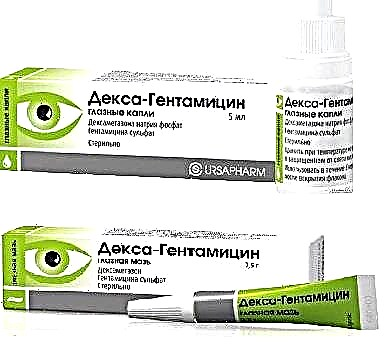
Two-year-old children are gradually getting used to adult food, but it is still too early to completely switch to a common table at this age. What nutritional features of a 2-year-old child should parents remember, what foods are still too early to try for a baby and how best to build a menu for a child of this age?

Diet
At the age of two, children's meals become four times a day and include breakfast and lunch, as well as afternoon tea and dinner. More frequent meals have a negative effect on appetite, while less frequent meals affect the digestion of food and the well-being of the baby. The breaks between meals are 3.5-4 hours.
The principles of good nutrition
- The ratio of proteins and fats, as well as carbohydrates in the diet of a 2-year-old child should be 1: 1: 4 or 1: 1: 3. Proteins are the main building blocks for the growth of the child's body, therefore, their sources such as dairy products, poultry, meat products, egg dishes, fish should be in the children's diet. Carbohydrates are the main source of energy for the child's body. The child gets them from cereals, fruits, sugar, bread, vegetables. Fats are also needed for the energy needs of the baby's body.
- A two-year-old child receives an average of 1400-1500 kcal per day. In terms of calorie content, meals should be distributed as follows: 25% of calories for breakfast, 30% of calories for lunch, 15% of calories for afternoon tea and 30% for dinner.
- It is important to ensure a sufficient supply of macro- and micronutrients, especially those responsible for the health of the bones. The child will receive calcium from cottage cheese, milk, cheese, peas, dried apricots, cabbage, prunes, oatmeal and other products.
- Spices and salt in baby's dishes should be kept to a minimum.

Baby needs at 2 years old
- Your baby should eat dairy products every day.... Kefir is recommended in amounts up to 200 ml per day.
- In addition to the yolk, you can start giving the white of the boiled egg. Half a boiled egg per day is considered the norm.
- Cheese the baby is recommended only with a low fat content and in the amount of 20 g per week.
- Cottage cheese recommended for 50 g per day. It can be mixed with fruits, sour cream, sugar. You can also make puddings, cheese cakes, dumplings from cottage cheese.
- Meat dishes prepared from lean veal, beef and pork. Also, children are given chicken. These dishes are recommended for consumption in the morning because they take a long time to digest. A sufficient amount of meat per day for a 2-year-old child is considered 50-80 g. It is permissible to include low-fat boiled sausage and lean boiled ham in the child's diet. You can also start offering your child meat stew and liver pâté at age two.
- Several times a week, the child replaces a meat dish with a fish dish. The fish is boiled, stewed, cutlets and meatballs are also made from it. A two-year-old baby can be given a piece of herring. A child should eat up to 175 g of fish per week.
- Vegetables the baby should consume up to 250 g per day, but potatoes are advised to consume up to 150 g per day. Vegetable purees can be single-ingredient or complex. A two-year-old can be given cabbage, beets, carrots, onions, pumpkins, eggplants, tomatoes, turnips, radishes, cucumbers, bell peppers and other vegetables.
- Fruits and berries recommended in an amount of about 150-200 g per day.
- The diet may contain pasta, as well as flour dishes.
- The norm of bread count up to 100 g per day (wheat - about 70 g, rye - about 30 g).
- The norm of confectionery is 10 g per day, and sugar - up to 50 g per day.
- In addition to cereals, the child can try cereal casseroles, as well as children's muesli. The most useful are oatmeal, buckwheat and rice porridge, as well as millet and corn. Barley porridge can already be introduced into the diet of a two-year-old child.
- Add to vegetable dishes vegetable oil up to 6 g per day.
- Butter it is advised to consume up to 16 g per day.

What fluids to give?
Water for every kilogram of weight of a 2-year-old child requires 100 ml per day. This daily amount of water includes any liquids that the child consumes (soups, compotes, milk, and others). If the weather is hot, the volume of fluid should be increased. On average, a child aged two years is advised to drink 1,500 ml of water per day.
A two-year-old child can be given weak tea, rosehip infusion, compote, cocoa, milk, fruit and vegetable juices. It is recommended to drink juice in an amount of up to 150 ml per day.
How to compose a menu?
- For breakfast, the child is given a main course in the amount of 200 g and a drink in the amount of 100-150 ml, as well as bread and butter or cheese.
- For lunch, it is useful for a child to eat a salad of fresh vegetables or other appetizer in the amount of 40 g and the first course in a volume of 150 ml. Also for lunch, the baby is given a meat or fish dish in the amount of 50-80 g and a side dish in the amount of 100 g. In addition, for lunch they give a drink, the volume of which will be 100 ml.
- For an afternoon snack, the child is recommended to milk or kefir in a volume of 150 ml, as well as cookies (15 g) or homemade cakes (45 g). In addition, fruit or berries should be given for an afternoon snack.
- For dinner, the child, as well as for breakfast, is given a main course in the amount of 200 g and a drink in a volume of 150 ml.

Sample menu for a week
A child of two years old can eat for a week according to approximately the following menu:
What should not be included in the diet?
At the age of two, children are not given:
- Fried dishes.
- Mayonnaise and ketchup.
- Chocolate.
- Dairy products with flavors, thickeners, colors and other additives.
- Sausages and sausages.
- Barley porridge.
- Spread and margarine.
- Duck and goose meat.
- Smoked products.
- Pickled foods.
- Mushrooms.
- Salted fish and seafood.
- Carbonated drinks.
- Coffee.

What are the best ways to cook food?
Food for a two-year-old child is boiled, baked, stewed, steamed. It is still too early to try fried food for children of this age. At the same time, food is already chopped less, and more often it is offered with a crushed fork and pieces. Vegetables can be fed either processed or raw.
Examples of useful recipes
Beetroot salad with cucumber and green peas
Take 50 g of beets and 25 g of fresh cucumber and green peas each. Boil peas and beets. Finely chop the cucumber, add cooked peas and grated beets. Season with 5 g of sunflower oil.
Apple and prune salad
Wash and peel the apple (70 g), grate on a coarse grater. Peel and soak prunes (30 g), then finely chop. Combine grated apple and chopped prunes, add a teaspoon of sugar or honey.
Soup with fish meatballs and potatoes
Take 300 ml of fish broth, bring to a boil, put potatoes (50 g), carrots (15 g), onions (10 g) and parsley root (5 g), cut into small cubes. Cook until vegetables are tender, then add fish fillet meatballs to soup. For them, take 60 g of fillet, half a chicken egg, 10 g of white bread crumb and 20 ml of milk. Wait for the meatballs to float. Season the soup with fresh dill (3 g).

Steamed meatloaf with omelet
Prepare a cutlet mass from 100 g of meat, a quarter of a chicken egg, 30 ml of milk and 20 g of white bread. Mix the ingredients well and place on cheesecloth dipped in cool water. You should get a layer of minced meat about 1.5 centimeters thick. Separately prepare a steam omelet with one egg and 25 ml milk. Place the omelet on top of the minced meat, carefully join the edges of the cheesecloth to make a roll. Steam for about 30 minutes.
Millet porridge with pumpkin
Take 150 ml of milk or water, bring to a boil, add peeled and diced pumpkin (100 g) and simmer for 7-10 minutes. At this time, rinse 30 g of millet groats in hot water several times. Pour it into water or milk with pumpkin, add a spoonful of sugar and cook for about 1 hour over low heat. Serve with butter.
Steamed cottage cheese pudding with raisins
For two portions, take 200 g of cottage cheese, grind it through a sieve, add 20 g of washed raisins. Mash the yolk of a chicken egg with 20 ml of milk and 16 g of sugar. Combine the crushed yolk with the curd mass, add 10 g of butter (you must first melt it) and 4 teaspoons of semolina. Add the beaten egg white last. Put the resulting mass in oiled molds. Steam for 30-40 minutes.
Possible problems
At the age of two, the child strives for independence. At this time, a developmental crisis begins to appear in many babies, which also affects the nutrition sector.

What if the child does not eat the foods he needs?
Many parents worry that the child is not eating enough, in their opinion, diverse. At the age of two, babies can eat the same dish for several days, and this is the norm. There is no need to worry if the child eats at least one product from these groups: dairy products, meat, vegetables, cereals and fruits. For example, if the baby's menu contains bananas, potatoes, chicken, bread and kefir, his food can be called varied.
If the child refuses food altogether, there is no need to insist and force. Offer your baby food at a specific time (according to the established diet), avoid snacks and make sure the food is of the right temperature and structure. The best tactic is to constantly offer food, but not have access to easily digestible sweets and other foods that the child can eat between meals. When the child gets hungry, he will eat what you give him.
How to understand that lack of appetite is a symptom of the disease?
In most cases, poor appetite is not associated with diseases, but with the presence of frequent snacks and a lack of food intake. Another difficulty can be caused by an overly large portion. Having seen a large amount of food, the discouraged child will hasten to refuse food altogether. It is best to give your child a small amount of food, and when he has eaten everything, offer a supplement.
However, poor appetite is indeed a sign of illness, for example, digestive tract diseases or any acute infections. The presence of other symptoms - fever, nausea, weight loss, changes in stool, and others - may suggest that poor appetite is associated with illness.

Binge eating
Teaching a child the basics of proper nutrition is important from early childhood, because obesity is a very common problem in adults. Parents should accustom their crumbs to healthy food. There is no need to be delusional and rejoice if a two-year-old eats large portions and has long since moved to a common table. This can undermine children's health and cause problems in the future.
Try to instill healthy eating habits in your child. It is best for the child to eat at the table with other family members.
Never use food as a reward or promise your child something for an empty plate.
Tips
- Try to give your child less muffins, shortcrust pastry, pies, pastries, and similar foods. They are high in calories and low in beneficial nutrients. Sweets that can be given to a two-year-old baby include marshmallow, jam, honey, cookies, preserves, waffles, jam, marmalade, marshmallows.
- If you are giving your child cottage cheese that is not intended for baby food, it should always be cooked.
- Since porridge for a 2-year-old child is advised to cook semi-viscous, then you need to take 4 times more liquids than cereals. You can cook porridge both in water and in fruit or vegetable broth and in milk.
- Do not let your child eat while walking, as this is dangerous.
- If your child still drinks from a bottle, you should give it up at the age of two. For kids who have not yet mastered a regular cup, buy a special (training) one.
Many parents give vitamins to a child from 2 years old. The expediency of this issue is discussed in another article.
You can watch how mothers feed their babies at 2 years old in the following videos.



